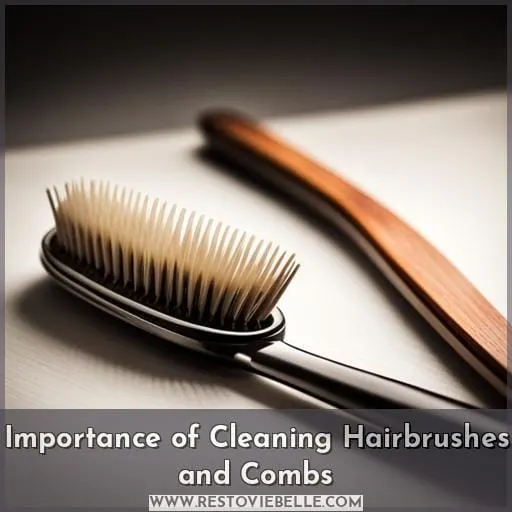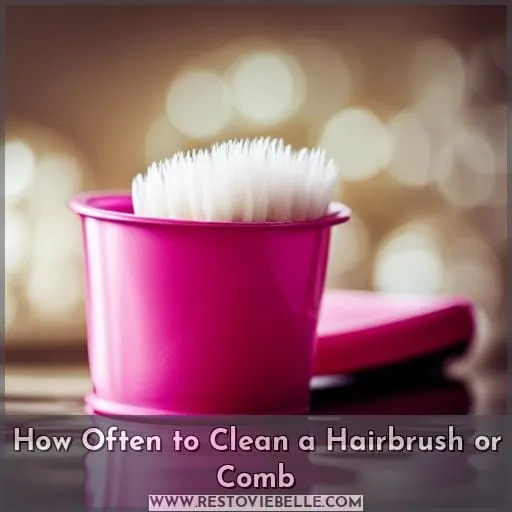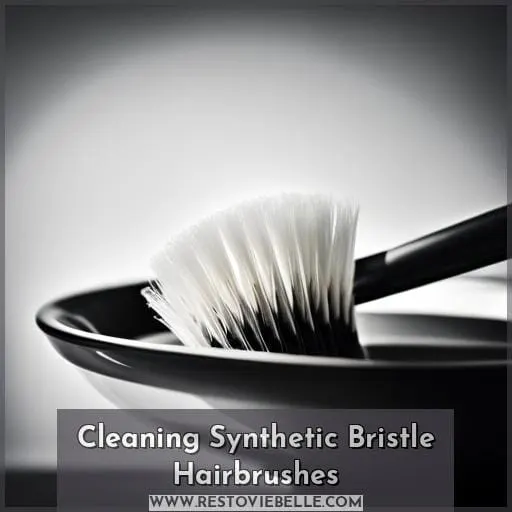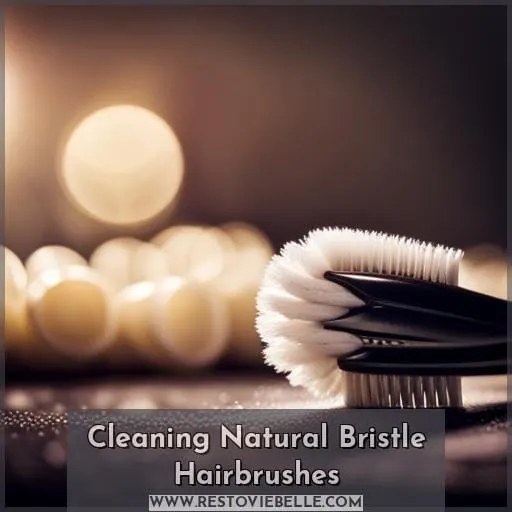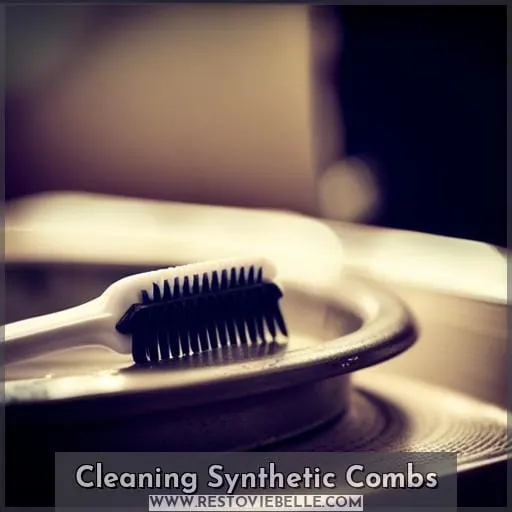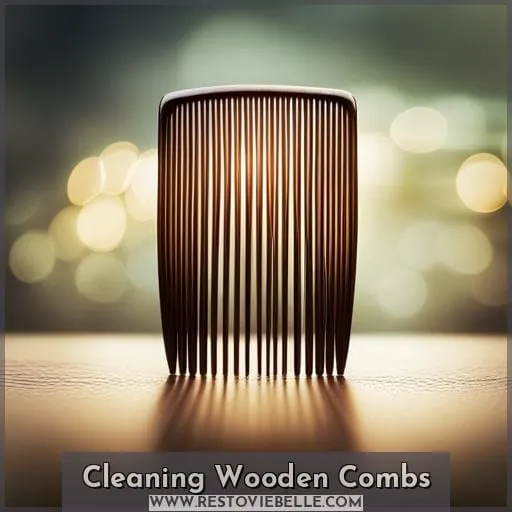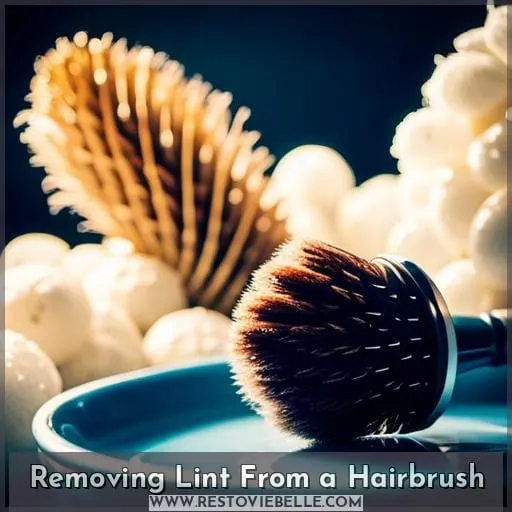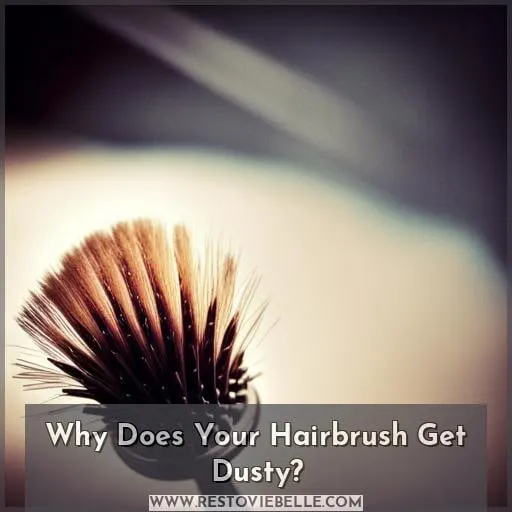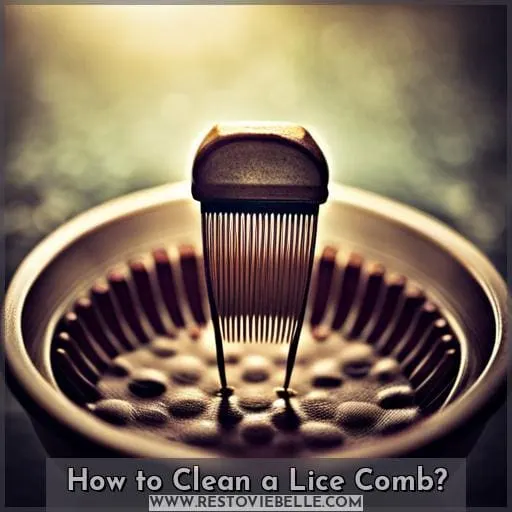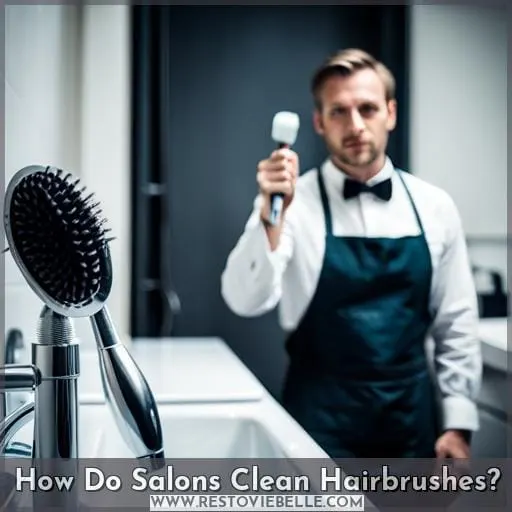This site is supported by our readers. We may earn a commission, at no cost to you, if you purchase through links.
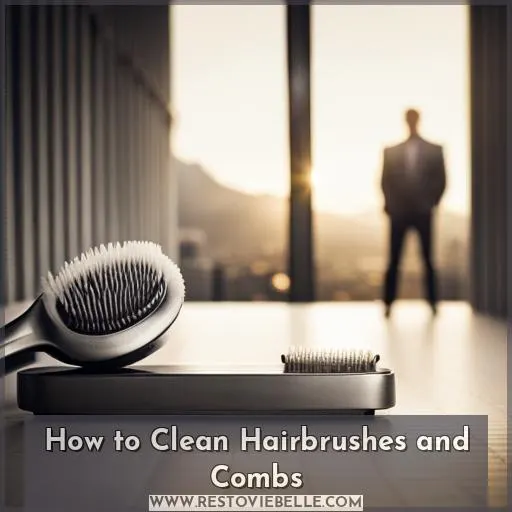 Imagine the satisfaction of running your fingers through clean, healthy hair. To achieve this, it’s important to pay attention not only to your hair but also to the tools you use on a daily basis.
Imagine the satisfaction of running your fingers through clean, healthy hair. To achieve this, it’s important to pay attention not only to your hair but also to the tools you use on a daily basis.
In this article on how to clean hairbrushes and combs, we will guide you through simple yet effective methods for maintaining cleanliness and hygiene in your styling routine.
Table Of Contents
- Key Takeaways
- Importance of Cleaning Hairbrushes and Combs
- How Often to Clean a Hairbrush or Comb
- Cleaning Synthetic Bristle Hairbrushes
- Cleaning Natural Bristle Hairbrushes
- Cleaning Synthetic Combs
- Cleaning Wooden Combs
- Removing Lint From a Hairbrush
- Why Does Your Hairbrush Get Dusty?
- How to Clean a Lice Comb?
- How Do Salons Clean Hairbrushes?
- Frequently Asked Questions (FAQs)
- Conclusion
Key Takeaways
- Cleaning hairbrushes and combs is essential for maintaining hair health and hygiene.
- Different types of brushes and combs require different cleaning frequencies and methods.
- Synthetic bristle brushes can be cleaned with warm, soapy water and baking soda for stubborn buildup.
- Natural bristle brushes should be washed with warm water and gentle shampoo, while wooden brushes should be wiped with a damp cloth and sanitized with rubbing alcohol.
Importance of Cleaning Hairbrushes and Combs
Cleaning hairbrushes and combs is essential for maintaining their effectiveness and promoting optimal hair health. Regular cleaning not only removes dirt, oil, dead hair, and product buildup from the bristles or teeth, but also prevents the distribution of these substances back into your clean locks.
By neglecting to clean your brushes and combs regularly, you risk compromising your overall hair hygiene.
The hygiene benefits of cleaning can’t be overstated. Buildup on brushes can lead to dandruff formation or exacerbate existing dandruff issues due to trapped oils and dead skin cells. Cleaning frequency varies based on individual needs; however, a general recommendation is at least once a month for most individuals.
To maintain cleanliness effectively without breaking the bank on salon visits every time you need a brush cleaned professionally, DIY solutions are readily available using common household items such as shampoo or dishwashing soap with warm water.
These homemade cleansers break down buildup effectively while being gentle enough not to damage brush bristles or comb teeth.
In addition to ensuring proper cleaning techniques are employed in removing dirt from different types of brushes (including round brushes), it’s crucial that drying techniques align with best practices so as not to let moisture linger which may promote bacterial growth within tools used daily by customers seeking healthy tresses!
How Often to Clean a Hairbrush or Comb
You should clean your hairbrush or comb on a regular basis to maintain optimal hygiene and effectiveness.
- Synthetic Bristles: Clean synthetic bristle brushes at least once a month.
- Natural Bristles: Natural bristle brushes require more delicate care, so clean them every two weeks.
Proper cleaning instructions include:
- Removing excess hair by hand or with tweezers.
- Washing the brush or comb with warm water and shampoo, depending on the type of bristles/materials used.
- Scrubbing between the teeth/bristles using an old toothbrush to remove dirt and residue effectively.
- Thorough rinsing under running water to ensure all soap suds are removed.
- Optional disinfection using gentle sanitizing sprays if necessary.
By following these cleaning instructions based on your brush type, you can keep your tools in top shape while maintaining good hygiene practices for healthy-looking hair!
Cleaning Synthetic Bristle Hairbrushes
To clean synthetic bristle hairbrushes effectively, there are a few key steps to follow:
- Start by removing any excess hair from the brush using a comb or your fingers.
- Then, wash the brush in warm, soapy water to create suds and scrub gently with a toothbrush.
- For stubborn product buildup, you can also scrub with dry baking soda.
- Rinse thoroughly with warm water and allow the brush to air-dry with the bristles facing down for optimal results.
Washing the Brush
To thoroughly clean your synthetic bristle hairbrush, start by washing the brush with warm water and shampoo.
Gently scrub between the bristles using a toothbrush to remove any dirt or product buildup.
Rinse well and air-dry before use.
Soaking the Brush
To effectively clean synthetic bristle hairbrushes,
- Soak the brush in warm soapy water to loosen dirt and product buildup.
This method allows for deep cleansing and ensures thorough removal of mineral buildup.
Scrubbing With Baking Soda
To scrub synthetic bristle hairbrushes with baking soda, gently massage the bristles and base of the brush using a toothbrush dipped in a mixture of warm water and baking soda. This method effectively removes product buildup, lint, gray fuzz, dead skin cells, and bacteria from your hairbrush.
Thorough Rinsing
After scrubbing your synthetic bristle hairbrush with baking soda, thoroughly rinse the brush under warm water.
This step is crucial for removing any remaining residue and ensuring optimal cleanliness.
Thorough rinsing promotes hairbrush hygiene by eliminating dead skin cells, bacteria, and fungi that can lead to scalp infections.
Sanitizing the Hairbrush
Now, to sanitize your synthetic bristle hairbrush, you can easily follow these steps:
First, remove excess hair.
Then wash the brush with warm soapy water and scrub gently with a toothbrush.
Rinse thoroughly and let it air dry for sanitizing efficiency.
Cleaning Natural Bristle Hairbrushes
When it comes to cleaning natural bristle hairbrushes, there are a few key steps to follow:
- First, you’ll want to wash the bristles using warm water and a gentle shampoo.
- Then, take care when cleaning the wooden brush handle by avoiding soaking and instead using a soapy toothbrush for thorough cleaning.
- After rinsing the brush under warm water, make sure to air-dry with the bristles facing down for optimal results.
Washing the Bristles
Start by gently washing the bristles of your natural bristle hairbrush.
Use a mild shampoo and warm water to create a lather.
Gently massage the bristles, removing any product residue or dirt.
Rinse thoroughly under running water and allow the brush to air dry completely before use.
Cleaning the Wooden Brush Handle
To clean the wooden brush handle on a natural bristle hairbrush, gently scrub the handle with a toothbrush and soapy water.
This helps maintain wood care and preserve the integrity of this natural material.
Regular cleaning of the wooden brush handle ensures hygiene maintenance in your hair care practices.
Rinsing the Brush
After washing the bristles of your natural bristle hairbrush, rinse the brush thoroughly under warm running water. This step is crucial to remove any remaining residue and ensure proper cleanliness.
- Use gentle circular motions to rinse all areas of the brush.
- Pay close attention to removing any soap or cleaning solution.
- Be careful not to damage or bend the bristles while rinsing.
Optional Sanitization
Continuing the process of cleaning your natural bristle hairbrush, you can choose to optionally sanitize it for added hygiene.
Sanitizing your brush is an effective way to eliminate germs and ensure a clean tool for styling.
Follow proper sanitation techniques and hygienic practices when sanitizing your hairbrush or comb.
Cleaning Synthetic Combs
To effectively clean synthetic combs, you’ll need to:
- Scrub the comb
- Sanitize it
Scrub the comb by:
- Removing any hair or debris that may be stuck between the teeth using a toothbrush or your fingers.
Sanitize the comb by:
- Soaking it in warm soapy water or isopropyl alcohol
- Allowing it to air dry completely before use.
Scrubbing the Comb
Scrub the comb gently to remove residue and buildup.
For effective techniques in cleaning synthetic combs, follow these maintenance routines and hygiene practices:
- Use warm, soapy water: Create a mixture of mild detergent and warm water to soak the comb.
- Scrub with an old toothbrush: Gently scrub the teeth of the comb using circular motions to dislodge dust, dandruff, and product buildup.
- Rinse thoroughly: Rinse the comb under running water until all soap residue is removed.
- Air-dry for brush restoration: Place the clean comb on a towel or drying rack with teeth facing downwards for complete drying before use.
By incorporating these deep cleansing tips into your haircare routine, you can ensure that your synthetic combs are kept clean and hygienic at all times.
Sanitizing the Comb
To sanitize the comb, simply rinse it thoroughly with warm water. This step helps remove any dirt or residue that may be present on the comb’s surface.
After rinsing, you can also consider using DIY solutions like vinegar or hydrogen peroxide to enhance sanitizing efficacy. These natural disinfectants have germ-killing properties and can help control bacteria on your comb.
Another option is to use UV sterilization devices specifically designed for hairbrushes and combs, which provide an efficient method of sanitation without the need for chemicals.
Regularly sanitizing your combs is essential in maintaining good hygiene practices and avoiding potential infections or scalp issues caused by dirty tools.
Cleaning Wooden Combs
When it comes to cleaning wooden combs, there are a few important steps to consider.
First, make sure the comb is completely dry before storing it to prevent moisture damage.
Second, if necessary, you can lightly sanitize the comb by using a disinfecting spray or wiping it with isopropyl alcohol.
Remember not to submerge the wooden comb in water as this can cause deterioration over time.
Drying the Comb
To dry the wooden comb after cleaning, simply place it on a clean towel and allow it to air-dry naturally.
Air drying is the preferred method for moisture control as it helps prevent damage to the wooden material.
Avoid using heat sources like hairdryers or dry heat ovens, as they can cause warping or cracking of the wood.
Humidity can also impact drying time, so ensure proper ventilation in the area where you place your comb.
Salons often follow this practice to maintain hygiene and preserve their clients’ brushes and combs effectively during use.
Sanitizing, if Needed
If you notice that your wooden comb requires sanitization, here’s a simple method to effectively clean and maintain its hygiene:
Start by wiping the comb with a damp cloth to remove any visible debris or residue.
Then, prepare a solution of equal parts water and rubbing alcohol.
Dip a clean cloth into the solution and gently wipe down the entire surface of the comb, paying attention to each tooth and crevice.
Allow it to air dry completely before using again for germ-free hairstyling tools.
Removing Lint From a Hairbrush
To remove lint from a hairbrush, start by using a toothbrush to gently sweep between the bristles horizontally and vertically.
Afterward, rinse out the brush under running water to remove any remaining residue.
Remember to always air-dry your hairbrush with the bristles facing downward to prevent moisture buildup.
Using a Toothbrush
Continue removing lint from your hairbrush by carefully using a toothbrush to sweep between the bristles horizontally and vertically.
The toothbrush’s small, bristled head allows for precise cleaning in hard-to-reach areas. Gently move the toothbrush back and forth, dislodging any trapped lint or debris.
This method effectively removes buildup without causing damage to the brush materials. Remember to rinse out the brush afterwards to remove any remaining residue before allowing it to air dry.
Incorporating this eco-friendly DIY solution into your regular hygiene practices ensures clean and well-maintained brushes.
Rinsing the Brush Again
After removing the lint from your hairbrush using a toothbrush, rinse the brush again under running water to ensure all remaining residue is removed.
It’s important to use proper rinsing techniques for effective cleaning. Consider the water temperature that works best for your hair type – warm or cool water is usually recommended. Gently massage and squeeze the bristles while rinsing to dislodge any trapped debris.
Once thoroughly rinsed, shake off excess water and pat dry with a clean towel before allowing it to air dry completely, bristles down, in order to maintain optimal drying methods and prolong its lifespan.
Why Does Your Hairbrush Get Dusty?
Your hairbrush accumulates dust due to various factors. Dust can easily settle on the bristles or teeth of your brush, making it appear dirty and unhygienic. Understanding why your hairbrush gets dusty can help you implement effective dust prevention tips and incorporate cleaning routines into your haircare regimen.
Here are some reasons why your hairbrush may gather dust:
| Factors | Explanation |
|---|---|
| Environmental Conditions | Living in a dusty environment or keeping the brush exposed to open air increases the likelihood of accumulating dust. |
| Shedding Hair | Your brush collects loose hairs every time you use it, which can attract additional dirt and debris over time. |
| Product Buildup | If you regularly use styling products like hairspray or dry shampoo, residue from these products can contribute to a dusty appearance on your brush. |
To prevent excessive accumulation of dust on your brushes, consider implementing proper hygiene practices and incorporating regular cleaning routines into your schedule. Additionally, storing brushes in clean environments away from excessive exposure to air pollutants will also help keep them free from unwanted particles.
By understanding why your hairbrush gets dusty and following recommended cleanliness practices, you’ll be able to maintain cleaner brushes that promote healthier-looking locks while ensuring optimal hygiene for yourself.
How to Clean a Lice Comb?
To clean a lice comb, simply soak it in warm soapy water. This specialized cleaning technique ensures effective sanitization and prevents infestations.
Here are some comb hygiene tips to keep in mind:
- Remove Lice and Nits:
Before soaking the comb, carefully remove any visible lice or nits by wiping them off with a tissue or rinsing them under running water.
- Soak the Comb:
Fill a basin or sink with warm water and add mild soap or shampoo to create suds. Place the lice comb into the soapy water and let it soak for at least 10 minutes to loosen any remaining debris.
- Cleaning Technique:
After soaking, use an old toothbrush to gently scrub along each tine of the comb, making sure all sides are thoroughly cleaned.
Once you have completed these steps, rinse off all soap residue from the lice comb using warm running water before allowing it to air dry completely.
How Do Salons Clean Hairbrushes?
Salons typically clean hairbrushes using a professional-grade disinfectant solution. These establishments adhere to strict hygiene standards and follow specific cleaning techniques for maintaining optimal cleanliness and safety.
Here’s how salons ensure their hairbrushes are thoroughly sanitized:
- Initial Inspection: Before cleaning, salon professionals conduct a visual inspection of the brush to identify any signs of damage or wear.
- Removal of Hair: The first step involves removing excess hair from the brush or comb using specialized tools like combs with fine teeth or tweezers.
- Disinfection Process: Salons employ various sanitization procedures depending on the type of brushes they use, including soaking them in disinfectant solutions specifically designed for salon practices.
- Drying and Maintenance: Once cleaned, the brushes are air-dried before being stored in a clean environment until their next use.
By following these professional maintenance protocols and utilizing effective sanitization procedures, salons can ensure that their clients receive hygienic services while achieving mastery over proper equipment care.
Frequently Asked Questions (FAQs)
Why does your hairbrush get dusty?
Your hairbrush may accumulate dust due to a combination of factors, such as:
- Airborne particles
- Dead skin cells
Regular cleaning helps prevent dust buildup, maintaining hygiene and ensuring optimal performance for your hairbrush.
How to clean a lice comb?
To clean a lice comb,
- Soak it in hot water for 10 minutes.
- Use a toothbrush to scrub the teeth and remove any remaining debris.
- Rinse thoroughly and allow it to air dry before using again.
How do salons clean hairbrushes?
Salons employ effective techniques to clean hairbrushes.
They often use a combination of soap, warm water, and gentle scrubbing with a brush or toothbrush.
Thorough rinsing ensures cleanliness before air-drying the brushes for future use.
How often should you replace your hairbrush?
To ensure optimal hair health and hygiene, it’s recommended to replace your hairbrush:
- Every 6-12 months for drugstore brushes
- 6 months for natural bristle brushes
- A few years for high-quality brushes
What are the signs I need a new hairbrush?
Signs you need a new hairbrush include:
- Missing or damaged bristles.
- If the brush remains dirty even after cleaning, it’s time for a replacement.
Regular maintenance and inspection ensure optimal performance and hygiene.
Conclusion
Achieve clean, healthy hair by paying attention to the cleanliness and hygiene of your hairbrushes and combs.
Regularly cleaning these tools will remove dirt, oils, and bacteria, ensuring fresh-looking locks.
Whether you have synthetic or natural bristle hairbrushes, or synthetic or wooden combs, there are simple yet effective methods to keep them clean.
Don’t forget to remove lint from your hairbrush using a toothbrush and rinse it again for a thorough clean.
By following these steps, you can maintain the cleanliness of your hairbrushes and combs, promoting the health of your hair.

